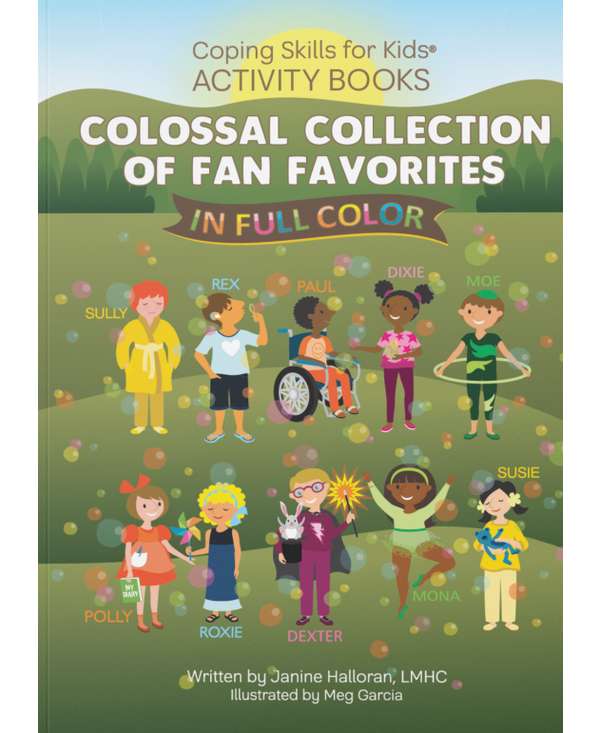- Reduced price






The Coping Skills for Kids Activity Books: Colossal Collection covers all 5 styles of coping skills, pulling fan favorite activities from the other coping skills activity books, but this time in FULL COLOR!
Here are the styles we break down for you:
Relaxation
Roxy and Rex enjoy coping skills designed to help them find inner peace, such as deep breathing, imagination strategies, and mindfulness.
Movement
Mona and Moe have a lot of extra energy in their bodies. They use skills that include small body movements like squeezing dough, and bigger movements like going for a walk or dancing, so they can cope in all kinds of places and situations.
Distraction
Dixie and Dexter like skills focused on enjoyable activities that give their brains a break, like playing a game, writing, listening and organizing, or solving a puzzle.
Sensory
Susie and Sully use their senses to help feel calmer and more grounded – like wrapping up in a blanket, feeling different textures, or noticing how their bodies feel when doing wall push ups or sitting in a beanbag chair.
Processing
Polly and Paul like to think about and express their thoughts and feelings, using problem-solving techniques and finding ways to focus on the good.
Using the coping styles helps you match a skill to how you feel, where you are and what you can do in the moment. Depending on your personality, you may prefer some styles over others. Like, you may be a kid who loves to run and jump, or a kid who prefers to sit quietly and read a book. Or, you might be a kid who likes to do both! Try them all and see what you like best.
There are many different kinds of coping skills for you to try in real life. You might be new to learning about coping skills, or maybe you already know a few and you’ll discover some new ones here.
Each activity page introduces you to a coping skill and helps you practice it. If you can’t get out to try a certain skill right then, pick another one that would suit the moment better, or do the activity and try the coping skill in real life later. Here are a few ways you may find to explore each coping skill further:
Coloring Pages
The coloring pages show the Coping Kids™ and Coping Critters™ using coping skills. After trying the skill shown in the coloring page, color it! As you color, think about how you felt when you used the skill.
Drawing and Tracing Pages
These activities ask you to draw or trace something that has to do with the coping skill. For example, one coping skill is taking a walk. The drawing activity for that skill is to draw your own walking path. An example of a tracing activity is moving like a snail. Afterwards, you trace the snail trails on the page!
Writing Pages
You can write, or have a trusted grown-up write for you. For example, for using a fidget, you can write down other fidgets you have tried, and whether or not you liked using them. Writing activities create a record you can come back to when you need ideas for more coping methods, or to remember what worked best.
BONUSES IN THE COLOSSAL COLLECTION ACTIVITY BOOK
BIG FEELINGS BOOKMARK
This double-sided bookmark may be clipped out of the book and taped or laminated. It can be used to mark the activity your child wants to do next, or where they last left off, as a traditional bookmark would. More importantly, it helps your child identify their feelings before and after using a coping skill. Before each activity, the bookmark guides your child to do a feelings check in. After coping with their feelings and completing the activity, they may use the back of the bookmark to measure their improved state of mind. This helps children identify their feelings and see that healthy coping skills can really work.
FIVE FAVES
This page is for kids to note the skills they respond to the most. These are their top five go-to coping skills. This is a powerful list. Share with kids that these are things they can do any me and anywhere they feel worried, anxious, or upset. Establishing priority coping skills gives children a point of reference for finding similar skill styles and creating their own
ON THE GO GO TO'S
Certain skills work better in some places rather than others. These four pages give a space for a child to list coping skills that work best at school, in stores/restaurants, during social events, or when they are on the road going someplace.